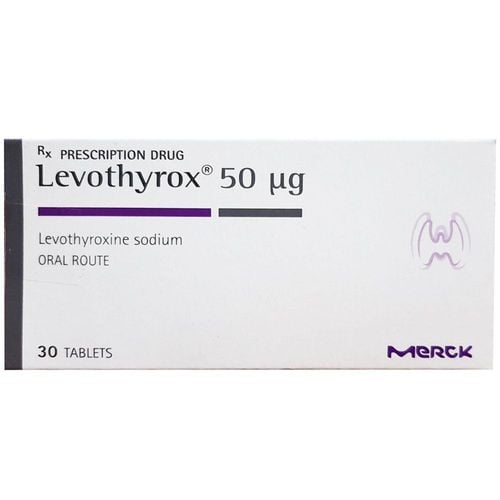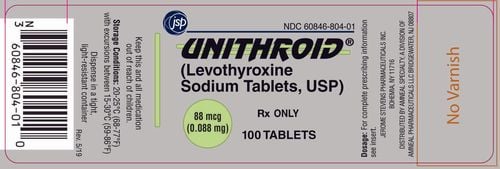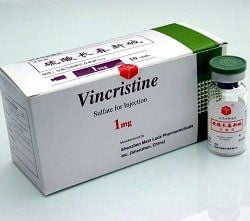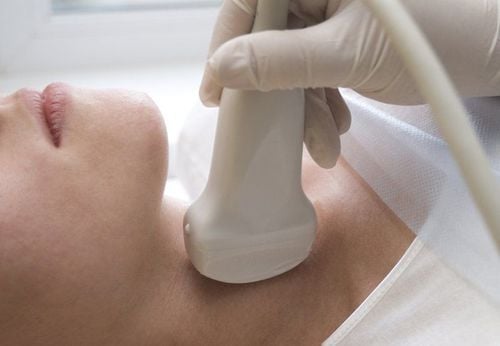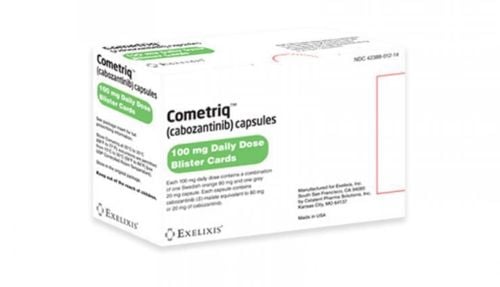This is an automatically translated article.
The article was consulted with Specialist Doctor II Le Thi My - Director of Thyroid Pathology Center - Department of Diagnostic Imaging and Nuclear Medicine - Vinmec Times City International Hospital.A thyroid nodule or nodule is an abnormal growth of thyroid cells that form a mass in the thyroid gland that changes the structure and endocrine function of the thyroid gland.
Although the majority of thyroid nodules are benign (noncancerous). But even if the proliferative mass is not cancerous, it can grow to a large enough size that can compress anatomical structures in the neck such as the trachea and esophagus, causing difficulty breathing or swallowing. neck area or creating a convex mass in the neck area that is aesthetically bad. So is thyroid nodule dangerous?
1. Causes of thyroid nodules
The cause and pathogenesis of thyroid nodules are still not really clear. However, the following factors can cause thyroid nodules:Natural hyperactivity of thyroid substances or infection, auto-infective thyroiditis Exposure to radioactive materials, use of certain medications Thyroid hormone synthesis Congenital disorders Patients with hypothyroidism, hyperthyroidism Smoking, iodine deficiency Genetics, genetics Females have a higher risk of thyroid disease than men
2. Symptoms of thyroid nodules
Usually, thyroid nodules have no symptoms. However, in some cases, thyroid nodules can cause the following symptoms:Large thyroid nodules make patients feel neck pain, difficulty breathing, difficulty swallowing, feeling stuck in the throat, hoarseness of voice due to the large thyroid nodule pressing on the trachea or esophagus. Normally thyroid nodules do not secrete hormones, do not affect thyroid function. However, in some cases, the thyroid nodules are overactive and secrete excessive hormones, causing hyperthyroidism - thyrotoxicosis, so patients may have some symptoms such as: trembling hands, fast or irregular heartbeat, nervousness and anxiety, Excessive sweating, insomnia, body fatigue, muscle weakness, rapid weight loss... Less commonly, thyroid patients may experience neck, jaw, or ear pain. Because most cases of thyroid nodules have no symptoms, the patient is only accidentally discovered when visiting a medical facility or through scan results to check for other health problems
3. Is thyroid nodule dangerous?
Depending on the type of tissue proliferating cells in the thyroid gland, thyroid nodules are defined as benign or malignant (thyroid cancer), mononuclear or multinodular.Due to the diverse histopathological characteristics of thyroid patients, to know if thyroid nodules are dangerous, the first thing is to check for diagnosis and classification of thyroid nodules, by a specialist.
Benign thyroid nodules will not be life-threatening, but annoying, affecting the patient's life and activities.
According to research, the incidence of thyroid cancer is not high, only about 4-5% of cases with thyroid nodules are malignant. If the thyroid nodule is malignant, the patient should be treated promptly with specialized doctors. With proper treatment, thyroid cancer can be cured.
If the thyroid nodule is benign, the patient can rest assured, with proper treatment, the disease will be stable and will not affect the overall health. However, if the thyroid nodule is enlarged and enlarged, it will cause swelling in the neck area, compressing other organs, causing discomfort.
Can thyroid nodules go away on their own?
Yes, thyroid nodules can go away on their own without treatment, but the incidence is not high. Therefore, if a tumor is found in the neck, the patient should see a doctor to monitor the size of the nucleus.
4. Radiofrequency ablation treatment of thyroid nodules at Vinmec
Radiofrequency ablation is a method of destroying tumors with heat, based on the friction mechanism of ions in the tissue under the influence of alternating current with high frequency from 300-500Mhz. Accordingly, an electrode is placed in the center of the tumor and maintained at a destructive temperature of 60 -100°C. Electric current from the machine is passed into the tumor through a needle-shaped electrode, radio waves are passed into the needle tip and heat is generated. Frictional heat dries the surrounding tissue leading to intracellular dehydration and coagulation necrosis of the tumor.Radiofrequency ablation technique is indicated for benign and malignant thyroid lesions:
For benign nodules:
Benign nodules causing neck symptoms: Neck pain , choking, feeling of mass in the neck, discomfort and cough. Forming a convex mass in the neck area that affects aesthetics. Toxic nodules - thyroid nodules that secrete a lot of thyroid hormone cause clinical hyperthyroidism. Mixed mass (including fluid - solid) recurred after treatment with absolute alcohol. For thyroid malignancies:
High-frequency ablation is indicated with the role of radical treatment or symptomatic relief and tumor size reduction. Specific indications for thyroid malignancies such as:
Micropapillary thyroid carcinoma (size ≤1cm, has not invaded beyond the thyroid gland, has not metastasized to the cervical lymph nodes) Local recurrent lesions or metastatic cervical lymph node metastases of thyroid K after surgery and repeated radiation therapy with resistance to I131 or high risk if re-operation. The large size thyroid cancer cannot be operated, radiofrequency ablation helps reduce the size and improve the symptoms of the neck area for patients. Radiofrequency ablation technique is contraindicated in the following cases:
Pregnant women Cardiovascular patients Patients with coagulation disorders Patients with severe co-morbid diseases such as heart failure, respiratory failure.. Patient has contralateral vocal cord paralysis. Procedure for performing radiofrequency ablation of the thyroid gland
Step 1: Preparation
Before performing the radiofrequency ablation technique, the patient will be completed by the interventionist doctors (visiting the examination, results of subclinical ultrasound, cytology, blood tests, indications for intervention, commitment to intervention,...) and explanation of risks and benefits of the method. The patient will then be signed a commitment to perform.
Step 2: Conduct
The doctor conducts ultrasound to determine the exact location of the thyroid nodules, the characteristics of the tumor, the size of the nodules and the volume of the thyroid nodules.
Sterile neck area with alcohol iodide Local anesthesia of the perithyroid space with Lidocaine 1% Percutaneous needle puncture of the neck area into the correct thyroid nodule under ultrasound guidance. Conduct ablation of thyroid nodules using high-frequency waves under the guidance of ultrasound. Radiofrequency ablation technique is a highly safe treatment method, because it does not require invasive skin incision and does not require anesthesia, so monitoring and re-examination is simple. After the ablation process ends, the patient only needs to lie down and monitor for 30 minutes to 1 hour, then can appear and resume normal activities without abstinence.
Radiofrequency ablation technique has been successfully applied in the treatment of benign thyroid neoplasms at Vinmec International General Hospital with very good results, the thyroid tumor volume decreased by 30-50% after 1 month. , 60-70% of the volume after 3 months and >90% of the volume after 12 months of burning, the patient has no scar on the neck area. This method helps to maximize the preservation of healthy thyroid parenchyma, so that the patient does not have to use thyroid hormone support after treatment.
Thanks to its outstanding advantages, treatment of thyroid tumors by radiofrequency is applied not only in the treatment of benign nodular goiter lesions, but has now been updated and applied in the treatment of lesions. thyroid malignancy. These are the following pathologies: papillary thyroid carcinoma (papillary cancer nuclei are <1cm in size, no cervical lymph node metastasis), local recurrent lesions or cervical lymph node metastasis of the patient. Thyroid cancer has been treated with surgery - radiotherapy.
Periodically after 1 - 3 - 6 - 12 months, the patient will be re-examined with an endocrinologist and radiologist who has directly performed the procedure for the most accurate and objective assessment results. .
To achieve the highest diagnostic and treatment efficiency, Vinmec has equipped with the most modern imaging equipment system today, typically the GE Healthcare E9 ultrasound machine with flat transducer, high frequency, HD resolution for clear images. Radiofrequency ablation technique to treat thyroid tumors under ultrasound guidance allows the doctor to control the entire procedure, ensure the best burning area is performed, and minimize vascular damage. , nerves, trachea, esophagus should be very safe, and at the same time reduce the maximum tumor size.
Please dial HOTLINE for more information or register for an appointment HERE. Download MyVinmec app to make appointments faster and to manage your bookings easily.





